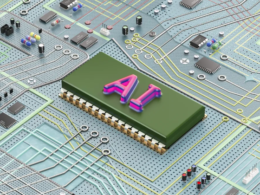the health strategist
platform
the most compreehensive knowledge portal
for continuous health transformation
and digital health- for all
Joaquim Cardoso MSc.
Chief Research and Strategy Officer (CRSO),
Chief Editor and Senior Advisor
December 5, 2023
What is the central message?
The article discusses six major trends in GenAI (General Artificial Intelligence) that are expected to shape the agenda in 2024.
It emphasizes the need for CEOs to be intentional in setting a top-down GenAI strategy, re-imagine entire domains rather than isolated use cases, buy selectively and build strategically, and focus on building scalable GenAI products rather than proofs-of-concept.
The central message is that while the past year has been marked by hype, 2024 is anticipated to be a year of lasting impact at scale for GenAI.

What are the key points?
Multi-Modal Capabilities:
Gen AI can now see, hear, and talk, spanning text, code, image, and audio, unlocking new possibilities in content generation and comprehension.
Interaction with the World:
Gen AI models can connect to data and IT systems to read and write data, enabling them to interact with the external environment.
Improved Control:
End users can achieve more consistent outputs from probabilistic models through new features, such as setting the seed, making Gen AI models easier to control.
Democratization of Gen AI Development:
OpenAI’s introduction of “GPTs” allows almost anyone to build a Gen AI-powered chatbot using low code/no code interfaces, democratizing Gen AI development.
Platform Play:
Gen AI is evolving into a platform, leading to the creation of marketplaces for GPTs where users can discover new applications and publish their own.
Cost Decline:
The costs of Gen AI continue to decline, with GPT-4 API costs reportedly decreasing two to three times for the average enterprise customer.
CEO Principles for Gen AI Agendas:
1. Be Intentional: Set a top-down Gen AI strategy, focusing on creating enduring strategic distance between the organization and its competitors.
2. Re-imagine Entire Domains: Move beyond isolated use cases and re-imagine entire workflows and domains for a seamless end-user experience and clear business outcomes.
3. Buy Selectively, Build Strategically: Balance the decision to buy or build Gen AI capabilities based on factors like cost, scalability, and strategic competitive advantages.
4. Build Products, Not POCs: Prioritize building scalable Gen AI products over proofs-of-concept, acknowledging the need for selective investments and scaling capabilities to meet ambitions.
DEEP DIVE

Six major GenAI trends that will shape 2024’s agenda
QuantumBlack, AI by McKinsey
Ben Ellencweig, Sam Bourton, Carlo Giovine, and Stephen Xu
November 30, 2023
What every CEO needs to know and what it means for their gen AI agendas

It’s hard to believe that ChatGPT is only a year old. The number of exciting new product launches over the past 12 months has been astonishing — and there’s no sign that things will slow down anytime soon. In fact, quite the opposite. Earlier in November, OpenAI hosted DevDay, where the company announced extensive offerings across B2C and B2B markets. Cohere has doubled down on its knowledge search capabilities and private deployments. And Amazon Web Services launched PartyRock, its no-code gen AI app-building playground.
We believe that this past month’s activity is setting the stage for what to expect in 2024 in the gen AI space. Here are six major trends happening across the space.
– Gen AI can see, hear, and talk. Multi-modal models spanning text, code, image, and audio unlock new capabilities across both content generation and comprehension.
– Gen AI can interact with the world. Gen AI models connect to data and IT systems to read and write data.
– Gen AI models are easier to control. End users get more consistent outputs from probabilistic models via new features (e.g., setting the seed)
– Gen AI development is being democratized. OpenAI announced a new product called “GPTs,” which allows nearly anyone to build a gen AI-powered chatbot using low code/no code interfaces.
– Gen AI is a platform play. Entire marketplaces of GPTs will be created. There, users will be able to discover new applications and publish their own.
– Gen AI costs continue to decline. For one, GPT-4 API costs declined two- to three-times for the average enterprise customer.
While the technology’s possibilities continue to grow, we believe there are four principles for CEOs to consider as they drive their gen AI agendas. The principles draw from our experiences building gen AI applications with our clients throughout 2023, as well as decades delivering digital and analytics transformations (covered thoroughly in our book Rewired).
Be intentional. Set gen AI strategy top-down.
Gen AI is a gold rush. Everyone from shareholders to employees to boards are scrambling to deploy the latest and most powerful gen AI tooling and many large organizations have 150-plus gen AI use cases on backlog. While we share their excitement (and admire their ambition!), we have found that allowing dozens of gen AI projects to spawn across an organization puts at-scale value creation at risk.
With the recent developments in the gen AI space, the Cambrian explosion of the use cases and opportunities only will continue to split the already divided attention of leadership teams. C-suites must bring focus with a top-down gen AI strategy, while constantly returning to the question of how the technology can help create enduring strategic distance between the organization and its competitors? Here are some examples from first movers:
1. Retails banks are increasing customer retention and offer conversion by deploying customer-facing chatbots and hyper-personalization.
2. Service operations are tackling ongoing labor shortages by building workflow co-pilots to improve productivity of existing labor forces to resolve customer requests on-time.
3. IT services players are growing market share by investing in software engineering productivity tools and pricing contracts more competitively.
Smart organizations are taking a 2×2 approach: Identify two fast use cases to register quick wins on the scoreboard and excite the organization, while working on two slower, more transformational use cases that will change day-to-day business operations.
Re-imagine entire domains rather than isolated use cases.
During 2023, most organizations began experimenting with gen AI, building one-off prototypes and buying off-the-shelf solutions. Yet as these solutions are rolled out to end users, organizations are struggling to capture value. For example, some organizations that have invested in Github Co-Pilot have yet to figure out how the value capture is passed back to the business. Organizations need to reframe from one isolated use case to the full software delivery lifecycle. Scrum teams need to commit to shipping more product features. Or sales need to offer more competitive pricing to their customers and win more business. If companies stop at just buying a new shiny tool, the productivity gains will not translate to bottom-line gains.
That often means re-imagining entire workflows and domains. This serves two purposes: 1) It creates a more seamless end-user experience by avoiding point solutions; and 2) organizations can more easily track value against clear business outcomes. For example, an insurer we have worked with is re-imagining its end-to-end claims process — from first notice of loss to payment. For each step along the way, the insurer has identified gen AI, digital, and analytics opportunities, while never losing sight of the claims adjustor’s experience. Ultimately, this full sizing across the value chain made a step-change impact on end-to-end handling time.
Buy selectively. Build strategically.
Matching the pace of innovation, many new startups and software offerings are entering the market, leaving enterprises with a familiar question: “Buy or build?”. On the “buy” side, we see organizations that are wary about investing in capabilities that likely will eventually be available for a fraction of the cost. These same organizations are also skeptical of off-the-shelf solutions, unsure if the software will perform at-scale without significant customization. As these solutions mature and prove their value, “buy” strategies will continue play a central role to any gen AI strategy.
Meanwhile, some organizations are finding compelling business cases to “Build,” as well. These players start by identifying use cases that create strategic competitive advantages against their peers, by compounding existing strengths in their domain expertise, workflow integration, or regulatory know-how. For example, deploying gen AI to accelerate drug discovery has become industry standard in the pharmaceutical industry. Additionally, organizations are making investments in data and IT infrastructure to enable their portfolio of gen AI use cases. For many organizations, there has been little to no investment in unstructured data governance. Now is the time.
Build products. Not POCs.
With the new tooling available, a talented engineer can build a proof-of-concept over a weekend. In some cases, this might be sufficient to serve an enterprise need (e.g., a summarization chatbot). However, for most use cases in a large enterprise context, proofs-of-concepts are not sufficient. They do not scale well into production and their performance rapidly degrades without the appropriate engineering and experimentation. At OpenAI’s Dev Day, engineers showed how hard it is to turn a POC into a production-grade product. At the start, a demo POC only achieved 45% accuracy for a retrieval task. After a few months and a dozen or so experiments (e.g., fine-tuning, re-ranking, metadata tagging, data labelling, model self-assessment, risk guardrails), the engineers achieved 98% accuracy.
This leads to two implications. First, organizations cannot seek near-perfection on every use case. They need to be selective about when it is worthwhile to invest scarce engineering talent to develop high-performance GenAI applications. For some situations, 45% accuracy may be sufficient to deliver business benefit. Second, organizations need to scale their gen AI capabilities to meet their ambitions. Most organizations have identified hundreds of gen AI use cases. And so, organizations are turning to reusable code components to accelerate development. Dedicated engineers, often sitting in a Centre of Excellence (COE), codify best practices into these code components, which allow subsequent gen AI efforts to build off the lessons learned from the trailblazing ones. We have seen these components accelerate delivery by 25% to 50%.
Throughout the past year, there has been an endless stream of GenAI news and hype. The coming year will likely be similar — but with a growing focus on delivering real business value to justify the billions in investment. From large enterprises to pioneering startups, organizations need to form their strategies around the decades-old principles from digital and analytics transformations. Organizations that get these tried-and-tested learnings right will form lasting strategic advantages against their competitors, creating sticky customer experiences and gaining market share in a challenging macroeconomic environment.
If 2023 was a year of hype, then 2024 will be the year of lasting impact at scale.
Originally published at https://medium.com











